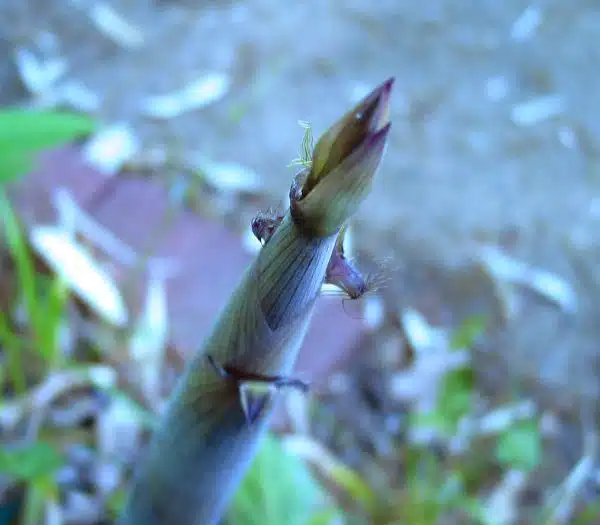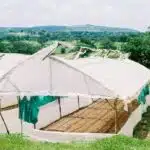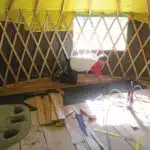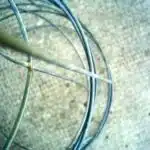Bamboo has been known for centuries as a versatile and resilient plant, but it can also be an invasive species that takes over a yard in no time. As a landscape expert/designer, I have encountered many clients who come to me with the same problem – how to get rid of bamboo from their yard. Bamboo is not only an eyesore, but it can also destroy other plants and trees in its path. In this article, I will provide you with tips on how to rid your yard of bamboo without causing harm to the environment or your surrounding vegetation.
It’s important to note that getting rid of bamboo requires patience and persistence. Bamboo has a strong root system that can reach up to five feet deep and spread several yards wide, making it difficult to completely remove. Many people make the mistake of cutting down the visible part of the plant without addressing the root system, leading to regrowth within months. In order to effectively remove bamboo from your yard, you must first understand its growth habits and take a strategic approach towards removing it. Follow these steps and you’ll be on your way towards restoring balance and beauty back into your yard.
Identifying Bamboo Species In Your Yard
Every landscape designer or homeowner has had to deal with the invasion of bamboo at some point. Bamboo is a fast-growing plant that can quickly take over a yard if not controlled properly. To eliminate bamboo from your yard, you need to learn how to identify it accurately.
Bamboo identification techniques are essential in controlling this invasive species. There are various ways to identify bamboo, including its leaves, culms, rhizomes, and shoots. Some common bamboo species in North America include Golden Bamboo, Black Bamboo, and Fargesia Bamboo. They usually have distinct features that make them easy to differentiate.
Golden Bamboo is easy to spot due to its yellow stripes on green leaves and its upright growth habit. Black Bamboo has dark stems that turn black as they age and create a beautiful contrast with green foliage. Fargesia Bamboo is often used for landscaping because of its non-invasive nature and clumping growth habit. Learning how to identify these species can help you determine the best control strategies for your yard. Understanding bamboo’s growth habits is the next step in eliminating it from your yard.
Understanding Bamboo’s Growth Habits
Bamboo is a fast-growing perennial plant that can spread quickly and become invasive in your yard. Understanding its growth habits is crucial to getting rid of it effectively. One important thing to know about bamboo is that it has an extensive root system, which can make removing it challenging. Its roots can spread up to 30 feet away from the main plant, making it difficult to eradicate completely.
Another important aspect of bamboo’s growth habits is its propagation techniques. Bamboo can spread through both runners and rhizomes, which are underground stems that produce new shoots. Runners are horizontal stems that grow on the surface of the soil, while rhizomes grow underground. Both types of stem allow bamboo to spread quickly and create new plants, making it essential to remove all parts of the plant thoroughly.
To get rid of bamboo effectively, you need to assess the extent of the infestation carefully. This means identifying all areas where bamboo is growing and determining how much space it covers. Once you have a clear understanding of the extent of the infestation, you can develop a plan for removing it. In the next section, we’ll discuss how to assess the problem and come up with a strategy for eliminating bamboo from your yard once and for all.
Assessing The Extent Of The Infestation
As a landscape expert, identifying bamboo root systems and assessing bamboo density is essential to getting rid of bamboo from your yard. To assess how deeply rooted the bamboo is, use a shovel or trowel to dig around the base of the plant. Determine whether you have clumping or running bamboo since they require different removal techniques.
Clumping bamboo grows in tight clusters and has a shallow root system, making it easier to remove. Running bamboo spreads quickly through underground rhizomes that can extend up to 20 feet away from the parent stem. This type requires more effort to eradicate as it can regenerate even after being cut down.
To determine the extent of your infestation, walk around your yard and look for new shoots emerging from the ground. These are indicators that there may be more extensive root systems beneath the soil surface. Identifying these areas will help you develop a removal plan that targets all areas of your property affected by this invasive species.
Assessing the extent of your infestation is crucial before beginning any removal process. With an understanding of how deeply rooted and widespread your infestation is, you can choose the right removal method that will be effective in eradicating this pesky plant from your yard.
Choosing The Right Removal Method
- Cutting bamboo is a viable removal method, but only applicable to small patches of bamboo and not effective for larger areas.
- Digging up the roots of bamboo can be laborious and time consuming, but is usually successful in removing all of the bamboo plants.
- Burning bamboo is not recommended due to the potential environmental and safety risks associated with it.
- Chemical spraying can be effective in controlling bamboo, although it will require multiple applications over a period of time.
- Mechanical removal is an option for larger areas of bamboo, but can be expensive and may require specialized equipment.
- Covering, fencing, mulching, and cultivating are all useful ways to contain bamboo, but will not necessarily remove the existing bamboo plants.
Cutting
Bamboo is a fast-growing and invasive plant that can be challenging to remove from your yard. Cutting is one of the most common techniques used to remove bamboo, but it requires proper safety measures to avoid injuring yourself or damaging the surrounding plants.
When deciding on cutting techniques for removing bamboo, it’s crucial to choose the right tools. A sharp pair of pruning shears or a handsaw can easily cut through bamboo stalks, while a chainsaw may cause more damage than necessary. It’s also essential to wear protective gear such as gloves and eye protection when cutting bamboo to prevent any injury from sharp edges or flying debris.
It’s important to note that simply cutting down the bamboo stalks will not completely eradicate the plant. To prevent regrowth, you must dig out the rhizomes, which are underground stems that give rise to new shoots. By combining cutting techniques with proper safety measures and thorough removal of rhizomes, you can successfully remove invasive bamboo from your yard.
Digging
When it comes to removing invasive bamboo from your yard, there are various methods to choose from. Cutting is one of the most common techniques used, but it’s important to note that this alone won’t eradicate the plant entirely. Digging out the rhizomes, which are underground stems that give rise to new shoots, is necessary to prevent regrowth.
To dig out the rhizomes, you’ll need appropriate tools such as a shovel or hoe for breaking up soil and a mattock for chopping through thick roots. It’s important to wear protective gear such as gloves and eye protection when digging to avoid any injury from sharp edges or flying debris. Digging safety tips include being cautious when using tools around other plants in the area and avoiding damaging any nearby utility lines.
Once you start digging, locate the rhizomes by following where the stalks emerge from the ground. Then, use a tool like a mattock to chop through and remove them completely. Depending on how established the bamboo is in your yard, this may take several attempts over time. By combining cutting techniques with proper safety measures and thorough removal of rhizomes, you can successfully remove invasive bamboo from your yard and prevent its regrowth.
Burning
In choosing the right removal method for invasive bamboo, it’s important to consider various factors such as the size of the area, level of infestation, and personal preferences. Cutting and digging out rhizomes are common techniques used, but another option is burning. This method involves setting fire to the bamboo stalks and allowing them to burn down to ash. However, before considering this approach, one must understand its potential risks and safety precautions.
Bamboo disposal through burning can be effective in eliminating large areas of bamboo quickly. The heat from the fire can destroy the rhizomes underground, preventing future regrowth. However, this method should only be attempted by professionals or those with experience in controlled burns. Safety precautions like having a water source nearby, clearing flammable materials around the area, and avoiding windy days should be taken into account.
It’s crucial to note that burning should not be used as a primary method for removing bamboo due to its risks. It can release harmful chemicals into the air and soil which can impact the environment negatively. Additionally, it’s not suitable for residential areas where fire regulations are strict. Thus, before resorting to this method, consult with local authorities or landscape experts on alternative options that prioritize safety and environmental preservation while effectively removing invasive bamboo from your yard.
Manual Removal Techniques
Choosing the right removal method for bamboo will depend on a few factors, including the size of the bamboo clump and the location of the plant. If you have a small area with bamboo growth, manual removal techniques are often the best option. However, if you have a large area with mature bamboo, more aggressive methods may be necessary.
Manual removal techniques for bamboo include digging out the entire plant or using pruning shears to cut the stalks down to ground level. Both methods require diligence and persistence since bamboo roots can spread several feet and regrow from any remaining rhizomes in the soil. To prevent future growth, consider installing a root barrier around the perimeter of your yard or garden bed.
Another effective way to control bamboo is through regular maintenance practices such as mulching and pruning. Mulch not only helps suppress new growth but also provides moisture retention for surrounding plants. Pruning can help shape and contain existing growth while removing any dead or damaged leaves.
- Use root barriers to prevent spreading
- Consistent mulching can suppress new growth
- Regular pruning can keep growth contained
In summary, manual removal techniques such as digging or pruning can be effective for controlling small areas of bamboo. Installing a root barrier and implementing regular maintenance practices such as mulching and pruning can help prevent future growth and keep existing growth contained. However, if you have a large area of mature bamboo or want a quicker solution, it may be necessary to explore other options such as chemical treatments for controlling bamboo growth.
Using Chemicals To Control Bamboo Growth
As a landscape expert, I have seen many homeowners struggle with removing bamboo from their yards. While there are natural bamboo control methods that can be effective, sometimes the best option is to use chemicals. However, it’s important to use them carefully and strategically.
One option for chemical control is to use herbicides specifically formulated for bamboo. These products contain glyphosate or imazapyr and must be applied directly to the leaves of the plant. It’s important to follow the instructions carefully and avoid applying on windy days or when rain is expected. Additionally, consider using bamboo root barriers to prevent regrowth.
Another chemical option is to apply a broad-spectrum herbicide to the entire area where bamboo has spread. This method will kill not only the bamboo but also any other plants in the area. To avoid this, use a selective herbicide that targets only bamboo and doesn’t harm surrounding plants. Regardless of which herbicide you choose, be sure to wear protective clothing and follow all safety precautions.
While using chemicals can be an effective way to get rid of bamboo, it’s important to remember that prevention is key. In the next section, we’ll discuss how you can prevent regrowth by taking proactive measures such as regular maintenance and monitoring for new growth.
Preventing Regrowth
Mulching and covering are two effective methods for preventing bamboo regrowth in your yard. Here are some tips to help you get started:
- Mulch the area around where the bamboo was removed. This will help to prevent any new shoots from sprouting up. Apply a thick layer of mulch, at least four inches deep, to the soil surface.
- Cover the area with a heavy-duty landscape fabric or plastic sheeting. This will help to suffocate any remaining root systems that may be trying to regrow. Secure the cover with stakes or rocks so that it does not move or blow away.
- Regularly inspect the covered area for any signs of new growth, and remove any shoots immediately.
It’s important to note that preventing bamboo regrowth can be a long-term process, as bamboo is known for being persistent and difficult to eradicate completely. However, by following these steps and consistently monitoring the area, you can greatly reduce the likelihood of new growth.
To completely remove bamboo rhizomes from your yard, there are several additional steps you can take.
Removing Bamboo Rhizomes
To prevent regrowth, it is important to establish a rhizome barrier. Bamboo can spread rapidly through underground rhizomes, so it is essential to create a physical barrier that will prevent them from growing back. This can be done by digging a trench around the perimeter of the bamboo patch and installing a rhizome barrier made of plastic or metal.
Bamboo containment is another effective way to eliminate bamboo from your yard. Containment involves removing all existing culms (above-ground shoots) and then carefully monitoring the area for any new growth. Any new shoots should be immediately cut down and removed, without allowing them to fully mature and produce more rhizomes.
By combining both methods, you can ensure that your yard remains free of invasive bamboo. However, if the bamboo has already established deep roots in your yard, it may be necessary to use heavy machinery to remove it completely. In the next section, we will discuss how to effectively remove bamboo using heavy machinery such as excavators and bulldozers.
Using Heavy Machinery To Remove Bamboo
- Renting heavy machinery is an efficient way to remove bamboo from a yard, as it can help expedite the process.
- Before attempting to remove bamboo, it is important to prepare the yard by clearing away any debris or furniture.
- Once the yard is prepped, the machinery should be operated in a safe and controlled manner while removing the bamboo.
- Care must be taken to ensure that the machinery is not damaging the surrounding vegetation or soil.
- After the bamboo is removed, the area should be inspected for any remaining roots or stalks.
- If necessary, additional steps can be taken to ensure the bamboo does not re-emerge.
Renting Heavy Machinery
As bamboo is known to be an invasive species, it can be quite challenging to remove it from your yard. One of the most effective ways to remove bamboo from your property is by using heavy machinery. Renting heavy machinery like excavators and bulldozers can make the job more efficient and less physically demanding. However, before renting any equipment, you need to consider cost considerations and safety precautions.
Cost considerations are crucial when renting heavy machinery to remove bamboo from your yard. The cost of renting heavy machinery varies depending on the type of equipment needed, rental period, and location. It’s essential to do some research before renting any machine. You should compare prices from different rental companies and choose the one that offers affordable rates without compromising quality. Additionally, you should factor in other expenses such as fuel costs and transportation fees when budgeting for the project.
Hiring professionals is another option if you don’t have experience operating heavy machinery or if you have a large-scale bamboo removal project. Professionals have the expertise and experience necessary to get the job done efficiently and safely. They also have access to specialized equipment that may not be available for rent in your local area. When working with professionals, ensure they are licensed and insured to avoid liability issues in case of accidents or damages during the project.
In conclusion, removing bamboo from your yard can be a daunting task but renting heavy machinery can make it easier and less time-consuming. Cost considerations are crucial when choosing which rental company to work with while hiring professionals is an excellent option for those who lack experience or have a significant project at hand. Remember always to put safety first when operating any heavy equipment in your yard.
Preparing The Yard
Prep work is necessary before using heavy machinery to remove bamboo from your yard. Clearing obstacles such as rocks, tree stumps, and other debris can help prevent accidents and damages to the equipment. Additionally, you need to identify any underground utilities such as gas lines or electrical cables that may be present in the area. Marking their location can help avoid damage during the digging process.
Soil preparation is crucial after removing bamboo from your yard. Bamboo has a shallow root system that can deplete nutrients and leave the soil compacted. Aerating the soil can help improve its quality and promote healthy growth of new plants. You can also add organic matter such as compost or manure to enrich the soil. Once the soil is prepared, you can consider different replanting options depending on your preferences and needs.
Replanting options after removing bamboo include choosing new plants that are compatible with your region’s climate and soil conditions. Selecting plants that have deeper root systems than bamboo can help prevent erosion and stabilize the soil. Additionally, adding ground covers or mulch around newly planted areas can help retain moisture and suppress weed growth. Proper care and maintenance of new plants are necessary for their survival, including regular watering, fertilizing, pruning, and pest control measures.
Removing The Bamboo
When it comes to removing bamboo from your yard, using heavy machinery is often necessary. However, it is crucial to prepare the area beforehand to prevent accidents and damages to equipment. One important factor to consider is the presence of bamboo root barriers that can make digging more difficult. Additionally, identifying any underground utilities in the area is vital for avoiding damage during the process.
Using natural herbicides can also be an effective way of removing bamboo before using heavy machinery. This method involves spraying a solution made from vinegar or a mixture of salt and water on the bamboo leaves to kill them off gradually. Once the bamboo has died, it becomes easier to remove with heavy machinery. However, this method may take several weeks or even months for complete removal.
After removing the bamboo, it is essential to dispose of it properly and prepare the soil for replanting. Removing any remaining roots and debris can help prevent regrowth and promote healthy growth of new plants. Adding organic matter such as compost or manure can also help enrich the soil and improve its quality. Overall, proper preparation and care are necessary for successfully removing bamboo and replanting in your yard.
Disposing Of Bamboo Waste
After successfully removing bamboo from your yard, you may be left with a significant amount of waste material. One option for disposing of this waste is through bamboo composting. Bamboo is rich in nitrogen and can add valuable nutrients to your compost pile. However, it is important to remember that bamboo can take longer to break down compared to other plant materials, so it may be necessary to cut the waste into smaller pieces before adding it to your compost.
Another option for disposing of bamboo waste is through bamboo crafts. Bamboo is a versatile material that can be used for various DIY projects such as baskets, furniture, and even musical instruments. By repurposing the bamboo waste into something useful or decorative, you are not only reducing waste but also unleashing your creativity.
It’s important to dispose of bamboo waste properly as it can harm other plants and trees if left untreated. Bamboo roots can continue to grow even after the plant has been removed, so make sure to remove all traces of the plant from the soil. Additionally, avoid burning the bamboo waste as it releases harmful chemicals into the air. Instead, consider using one of the above methods or consult with your local waste management facility for proper disposal options.
Protecting Other Plants And Trees
When removing bamboo from your yard, it is important to consider how neighboring plants may be affected. Bamboo has an aggressive root system that can damage and overtake the roots of other plants. To protect your garden, it is recommended to create a barrier between the bamboo and surrounding vegetation. This can be done by installing a physical barrier made of concrete or metal, or by planting a dense hedge of bushes or trees.
Another way to protect neighboring plants is to monitor the removal process closely. When digging up bamboo roots, try to minimize disturbance to the soil and surrounding plants as much as possible. Consider using hand tools instead of heavy machinery to avoid accidental damage. Once the bamboo has been removed, carefully inspect the area for any remaining roots or shoots that may continue to grow.
Root system damage from bamboo can also occur underground, making it difficult to detect. If you suspect that bamboo may have damaged neighboring plant roots, consult with a professional landscaper or arborist who can assess the extent of the damage and recommend appropriate solutions. In some cases, it may be necessary to remove damaged plants altogether in order to prevent further spread of invasive species.
Monitoring for regrowth is an essential part of eradicating bamboo from your yard. In the next section, we will discuss steps you can take to ensure that new shoots do not emerge and establish themselves in your garden once again.
Monitoring For Regrowth
After successfully eradicating bamboo from your yard, it is crucial to monitor the area for any signs of regrowth. Bamboo is notorious for its ability to spread quickly, so keeping an eye out for new shoots is essential. You may need to continue using some of the cost-effective methods previously mentioned, such as cutting down any new growth or applying herbicides.
Preventing regrowth in the long term requires a more strategic approach. One effective method is to plant ground cover plants that can compete with bamboo and prevent it from growing back. Another option is to install a physical barrier around the affected area. However, it’s important to note that these solutions are only effective if done correctly and consistently over time.
Overall, monitoring for regrowth and implementing long-term prevention solutions are key components of successful bamboo eradication. By taking these steps and staying vigilant in your efforts, you can ensure that your yard remains bamboo-free for years to come.
- Don’t let bamboo take over! Learn how to effectively eradicate it from your yard.
- Discover cost-effective methods to get rid of stubborn bamboo once and for all.
- Take control of your yard by implementing long-term solutions that will prevent regrowth and keep your space looking beautiful.
Transition: Now that you have successfully eradicated bamboo and prevented regrowth, creating a barrier to prevent further spread should be your next step.
Creating A Barrier To Prevent Bamboo Spread
- When choosing a barrier to prevent bamboo spread, it is important to consider the type of bamboo, the size of the bamboo, and the size of the area affected.
- Installing a barrier requires digging a trench around the affected area, at least 12 inches deep, and lining the trench with a barrier material such as black plastic, metal flashing, or a thick rubber membrane.
- The barrier should extend deep enough to prevent any new shoots from emerging, and should be sloped outward to prevent water from pooling against the barrier.
- To maintain a barrier, it is important to inspect the barrier both above and below the ground to ensure that it is still intact and not allowing any new shoots to emerge.
- Any shoots that do emerge through the barrier should be cut off and removed as soon as possible to prevent further spread.
- In addition, any dead or dying bamboo should be removed to help control the spread of the invasive species.
Choosing A Barrier
As a landscape professional, I understand the importance of creating a barrier to prevent the spread of bamboo in your yard. There are various types of bamboo barriers available on the market today, each with its unique advantages and disadvantages. The most popular types are plastic and metal.
Plastic barriers are easy to install and can last for many years. They come in different thicknesses and heights, allowing you to choose one that best suits your needs. However, they may not be as effective as metal barriers when it comes to stopping the spread of bamboo roots.
Metal barriers, on the other hand, are more expensive than plastic ones but offer better protection against invasive plants like bamboo. They are made from galvanized steel or aluminum and can withstand harsh weather conditions. The installation process is more involved than with plastic barriers, but they typically last longer and require less maintenance.
In conclusion, choosing the right type of bamboo barrier is crucial in preventing the spread of this invasive plant in your yard. Whether you opt for a plastic or metal barrier, it’s important to follow the installation process correctly for maximum effectiveness. With these tips in mind, you’ll be able to create a successful barrier that will keep your yard free from unwanted bamboo growth for years to come.
Installing A Barrier
When it comes to preventing the spread of bamboo in your yard, installing a barrier is one of the most effective methods. There are two options for installation: DIY or professional. If you have experience with landscaping and construction, you may be able to install the bamboo barrier yourself. However, if you’re not confident in your abilities, it’s best to hire a professional.
The cost of installing a bamboo barrier can vary depending on whether you choose to do it yourself or hire someone else. DIY installation is typically more affordable since you won’t have to pay for labor costs. However, if you make mistakes during the installation process, it could end up being more expensive in the long run. Professional installation ensures that the job is done correctly and efficiently but will come at a higher cost.
Regardless of which option you choose, investing in a bamboo barrier is essential in maintaining the health and beauty of your yard. By creating a physical barrier between your property and invasive bamboo roots, you can prevent damage to structures and other plants while also preserving the natural aesthetics of your outdoor space.
Maintaining A Barrier
Creating a bamboo barrier is an effective way to prevent the spread of invasive bamboo roots in your yard. However, once you have installed the barrier, it’s essential to maintain it regularly. Maintaining your bamboo barrier involves inspecting it frequently for any signs of damage or wear and tear. This step is crucial because if the barrier is damaged, it won’t be able to effectively prevent the spread of bamboo roots.
One way to maintain your bamboo barrier is by ensuring that it remains intact at all times. You can do this by checking the barrier periodically for any cracks or holes that may have formed over time. If you notice any damage, repair it immediately using eco-friendly barriers or cost-effective solutions such as natural adhesives, which are non-toxic and safe for the environment.
Another important aspect of maintaining your bamboo barrier is monitoring its height regularly. Bamboo has a reputation for growing fast and tall, so it’s essential to ensure that your barrier stays at a suitable height to control its growth effectively. By trimming any new shoots or growths that appear near the edge of the barrier, you can prevent them from escaping into other areas of your yard, keeping the bamboo contained within its designated area.
In conclusion, creating a bamboo barrier is an excellent way to prevent invasive roots from taking over your yard. However, maintaining this barrier requires diligence and care. By inspecting and repairing any damages promptly and keeping track of its height, you can ensure that your bamboo barrier remains effective in protecting your property while also preserving the natural beauty of your outdoor space.
Seeking Professional Help
Did you know that bamboo is one of the fastest-growing plants in the world? In fact, some species can grow up to 91 cm per day! This means that if you have bamboo in your yard, it can quickly become overwhelming and difficult to manage. If you’ve tried all the DIY methods and still can’t get rid of your bamboo problem, it may be time to consider hiring professionals.
When seeking professional help for bamboo removal, it’s important to do your research and find a reputable company with experience in handling this type of job. The cost of removal services will vary depending on factors such as the size of your yard, the extent of the bamboo growth, and whether or not any heavy machinery is required. However, investing in professional removal services can save you time and money in the long run by ensuring that the job is done efficiently and effectively.
Overall, hiring professionals for bamboo removal is a wise choice for those who are struggling to keep up with their yard maintenance. Not only will it save you time and energy, but it will also provide peace of mind knowing that the job is being taken care of by experts in the field. So don’t hesitate – reach out to a trusted removal service today and take back control over your yard!
Transition: Now that you’ve successfully removed the bamboo from your yard, it’s important to take steps to maintain a beautiful and healthy garden space.
Maintaining A Bamboo-Free Yard
After successfully removing bamboo from your yard, it is important to take measures to prevent its return. A bamboo plant can grow back quickly if a single root remains in the soil. Therefore, regular maintenance is necessary to ensure that your yard stays bamboo-free.
One way to maintain a bamboo-free yard is by regularly inspecting the area for any signs of new growth. If you notice any new shoots, immediately remove them and their roots using a shovel or hoe. Another effective method is to apply organic alternatives such as vinegar or salt to the soil around the area where the bamboo was growing. This will help kill any remaining roots and prevent new growth.
Professional landscaping services can also be a valuable resource in maintaining a bamboo-free yard. They have access to specialized tools and equipment that can effectively remove even the toughest bamboo roots. Additionally, they can provide ongoing maintenance services that will keep your yard free of unwanted plants.
- Regularly inspect your yard for signs of new growth
- Apply organic alternatives such as vinegar or salt
- Use professional landscaping services for effective removal and ongoing maintenance
- Consider planting alternative landscaping options that are more suitable for your climate and soil type
- Implement preventative measures such as installing root barriers before planting any new vegetation
By taking these measures, you can ensure that your yard remains beautiful and healthy without the pesky presence of invasive bamboo plants. Remember, prevention is key when it comes to maintaining a beautiful landscape.
Conclusion
Bamboo can be a beautiful plant, but it can quickly become an invasive species that takes over your yard. Identifying the species of bamboo in your yard, understanding its growth habits, and assessing the extent of the infestation are important first steps in getting rid of it. Manual removal techniques such as digging out roots or cutting down stalks can be effective, but monitoring for regrowth and creating a barrier to prevent spread are also necessary.
It’s important to remember that getting rid of bamboo is not a one-time task. Consistent maintenance and vigilance are required to keep it from creeping back into your yard. Seeking professional help may also be necessary for larger infestations or if manual removal methods prove unsuccessful.
As the saying goes, “An ounce of prevention is worth a pound of cure.” Taking preventative measures such as regularly checking for new shoots and planting barriers can save you time and effort in the long run. With patience and persistence, you too can have a beautiful, bamboo-free yard.
Image Credits
- “bamboo” by moxlux (featured)





























